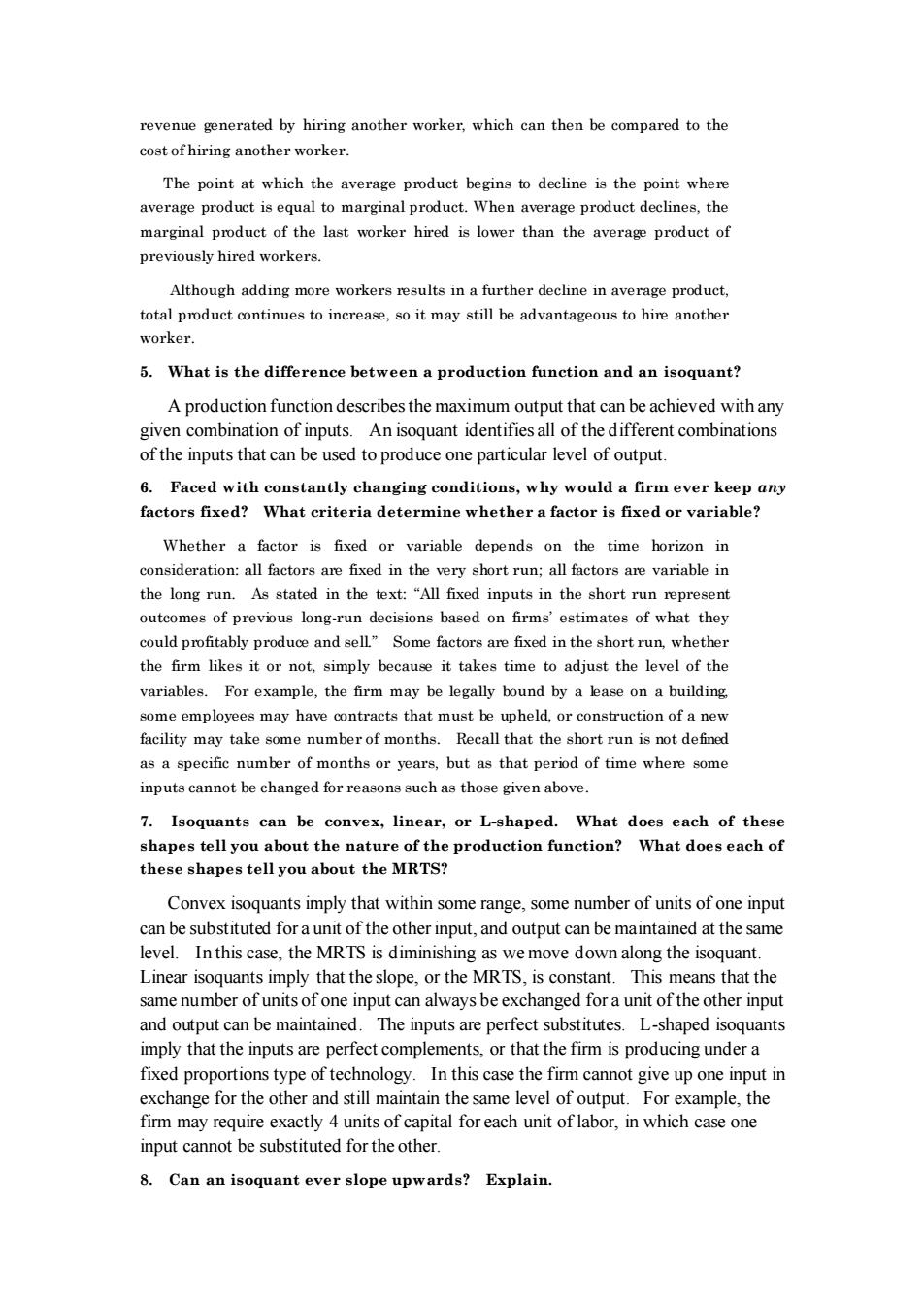正在加载图片...

revenue generated by hiring another worker,which can then be compared to the cost of hiring another worker The point at which the average product begins to decline is the point whe average product isequal tomarginal product.When average product declines the marginal product of the last worker hired is lower than the average product of previously hired workers. Although adding more workers results in a further decline in average product, total product continues to increase.so it may still be advantageous to hire another worker. 5.What is the difference between a production function and an isoquant? A production function describes the maximum output that can be achieved with any given combination of inputs.An isoquant identifiesall of the different combinations of the inputs that can be used to produce one particular level of output. 6.Faced with constantly changing conditions,why would a firm ever keep any factors fixed?What criteria determine whether a factor is fixed or variable? Whether a factor is fixed or variable depends on the time horizon in consideration:all factors are fixed in the very short run:all factors are variable in the long run.As stated in the text:"All fixed inputs in the short run out omes previous long-run ons based on firms mates of wha the: could profitably produce and sell"Some factors are fixed in the short run,whether the firm likes it or not,simply because it takes time to adjust the level of the variables.For example.the firm may be legally bound by a lease on a building ome employees may that must be upheld,or construction of a nev take mbe of Recall that th。 as a specific number of months or years,but as that period of time where som inputs cannot be changed for reasons such as those given above. 7.Isoquants can be convex,linear,or Lshaped.What does each of these shapes tell you about the nature of the production function?What does each of these shapes tell you about the MRTS? Convex isoquants imply that within some range,some number of units of one input can be substituted foraunit of theother input,and output can be maintained at the same level.In this case,the MRTS is diminishing as we move down along the isoquant. Linear isoquants imply that the slope,or the MRTS,is constant.This means that the same number of units of one input can always be exchanged for a unit of the other input and output can be maintained.The inputs are perfect substitutes.L-shaped isoquants imply that the inputs are perfect omple tsor that the firm is producing undera fixed proportions type of technology.In this case the firm cannot give up one input in exchange for the other and still maintain the same level of output.For example,the firm may require exactly 4 units of capital for each unit of labor,in which case one input cannot be substituted for the other. 8.Can an isoquant ever slope upwards?Explain. revenue generated by hiring another worker, which can then be compared to the cost of hiring another worker. The point at which the average product begins to decline is the point where average product is equal to marginal product. When average product declines, the marginal product of the last worker hired is lower than the average product of previously hired workers. Although adding more workers results in a further decline in average product, total product continues to increase, so it may still be advantageous to hire another worker. 5. What is the difference between a production function and an isoquant? A production function describes the maximum output that can be achieved with any given combination of inputs. An isoquant identifies all of the different combinations of the inputs that can be used to produce one particular level of output. 6. Faced with constantly changing conditions, why would a firm ever keep any factors fixed? What criteria determine whether a factor is fixed or variable? Whether a factor is fixed or variable depends on the time horizon in consideration: all factors are fixed in the very short run; all factors are variable in the long run. As stated in the text: “All fixed inputs in the short run represent outcomes of previous long-run decisions based on firms’ estimates of what they could profitably produce and sell.” Some factors are fixed in the short run, whether the firm likes it or not, simply because it takes time to adjust the level of the variables. For example, the firm may be legally bound by a lease on a building, some employees may have contracts that must be upheld, or construction of a new facility may take some number of months. Recall that the short run is not defined as a specific number of months or years, but as that period of time where some inputs cannot be changed for reasons such as those given above. 7. Isoquants can be convex, linear, or L-shaped. What does each of these shapes tell you about the nature of the production function? What does each of these shapes tell you about the MRTS? Convex isoquants imply that within some range, some number of units of one input can be substituted for a unit of the other input, and output can be maintained at the same level. In this case, the MRTS is diminishing as we move down along the isoquant. Linear isoquants imply that the slope, or the MRTS, is constant. This means that the same number of units of one input can always be exchanged for a unit of the other input and output can be maintained. The inputs are perfect substitutes. L-shaped isoquants imply that the inputs are perfect complements, or that the firm is producing under a fixed proportions type of technology. In this case the firm cannot give up one input in exchange for the other and still maintain the same level of output. For example, the firm may require exactly 4 units of capital for each unit of labor, in which case one input cannot be substituted for the other. 8. Can an isoquant ever slope upwards? Explain